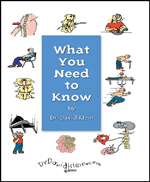
What are protons, neutrons and electrons?
Everything around us- air, water, sand, stone, wood, plants, animals, humans- scientists call them all matter.
When we analyze the structure of matter, we see that all matter is made essentially of about a hundred pure substances called elements in different combinations. Some elements do not combine with others and stay in pure form. But in most cases, two or more elements combine to form different substances. These combined substances are called compounds.
For example, the water we drink is a compound of two elements- hydrogen and oxygen. Our common table salt is nothing but a compound of the elements sodium and chlorine. But beware, sugar is a little more complicated - it has carbon in addition to hydrogen and oxygen! Many substances around us, especially the things that make up plant and animal matter, are far more complicated.
But the fact remains- complicated or simple, all matter is made up of elements. Each element is unique- it has its own special qualities. When you break up these elements into smaller and smaller pieces, you will finally get a tiny speck called an atom. Atom is the limit- you cannot break up the atom of an element and expect to see that element’s special qualities continued.
For a long time scientists believed that it is not possible to break up an atom. However some great scientists like J.J. Thomson, Goldstein and Chadwick later discovered that atoms are made up of three particles called Protons, Neutrons and Electrons. These particles are today called sub-atomic particles.
Protons, neutrons and electrons are very tiny particles. They are many times smaller than the smallest speck we can see with our naked eyes. The weight of a proton is somewhat close to the weight of a hydrogen atom, which is the smallest of all atoms. The weight of a neutron is almost the same as a proton. If you divide the weight of a hydrogen atom by 1837, you will get the weight of an electron. Thus electron is the lightest of the subatomic particles.
Of these three particles, protons and electrons have electrical charge on them. Each proton has one unit positive charge on it. Each electron holds one unit of negative charge. Neutrons are not charged particles. The number of protons and electrons in an atom is equal, so they cancel out each other and thus the atom does not have electrical charge on it.
When we speak of things like weight in our everyday life, we use units like grams and kilograms to measure them. We talk of electricity in terms of amperes and watts. However the world of protons, neutrons and electrons is so small we cannot use these units to show their weight or electric charge. Scientists use special units to talk about them.
Protons and neutrons always stay together at the centre of an atom. This part is called the nucleus. The electrons go on circling around the nucleus at very high speeds through special tracks called orbits. This might remind you of our solar system where the planets go on orbiting the sun. Well, the picture is pretty similar except that one is very huge and the other is very tiny.
We found that each atom is made of protons, electrons and neutrons. The atoms of each element have a different number of protons and electrons. No two different elements can have the same number of protons and electrons in their atoms. Hydrogen has one proton and electron in its atom and helium has two protons and electrons in its atom. Oxygen has eight protons and electrons in its atom. Thus it is the number of protons and electrons in the atom that makes each element unique. Scientists explain each element’s behavior using the number of protons, electrons and neutrons it has.
We found earlier that all matter is made up of atoms. Now that we know of protons, neutrons and electrons, we can modify our statement. All matter, everything we see around us, is made up of protons, neutrons and electrons!